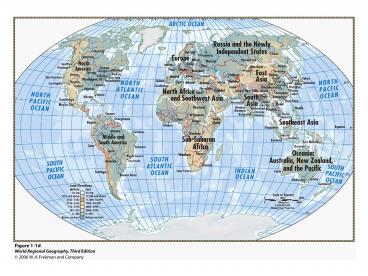World Regional Geography political trends - PowerPoint PPT Presentation
1 / 14
Title:
World Regional Geography political trends
Description:
World Regional Geography political trends. The world of ... Radical Islam versus modernism. Terrorism. Violent acts directed at civilians. State terrorism ... – PowerPoint PPT presentation
Number of Views:77
Avg rating:3.0/5.0
Title: World Regional Geography political trends
1
World Regional Geography political trends
- The world of nations and states
- 192 countries are members of the United Nations
- Largest in population China 1.36 Billion
- Smallest in population Liechtenstein 31,000
- Largest in size Russia 6.6m sq. miles
- Smallest in size Monaco 1 sq. mile
- (leaving out Vatican City)
2
World Regional Geography political trends (cont)
- Sovereign States are the basic legal entity into
which the world has been divided - De jure boundaries defined by and
internationally recognized borders - Many are a product of conflict and territorial
competition - rather than natural boundaries defining
individual cultural groups - In particular, most of the boundaries of Africa,
Asia and the Middle East (e.g., Iraq) - defined during the last decades of the 19th
century and the first decades of the 20th
century, - e.g., Conference of Berlin in 1888
3
World Regional Geography political trends (cont)
- Boundaries imposed on those peoples for the sake
of - Administrative control
- Avoid conflict between Europeans as they
colonized much of the rest of the world - After independence most of those boundaries
remained the same - Have resulted in considerable conflict since then
4
(No Transcript)
5
World Regional Geography political trends (cont)
- De Jure boundaries are relatively stable
- Most of the worlds countries dont like to see
country boundaries change - Why?
- Some dynamism in boundaries also (e.g.,)
- Break up of the Soviet Union into 15 countries
- Joining of North and South Vietnam
- Boundary changes between Morocco and Mauritania
- Boundary conflicts
- Greece and Turkey
- France and Italy
- Israel and Palestine
6
World Regional Geography political trends (cont)
- De facto boundaries
- Much more complex and difficult to identify and
can occur within or across countries - Two or more groups of people that consider
themselves radically different from each other - Perpetuated through time
- May go back hundreds of years
- Very difficult to solve
7
De Facto Boundaries
- Defined by
- Ethnic, cultural or ideological differences and
historical conflict between similar peoples - E.g., Northern Ireland (unionists and
nationalists) - Lebanon (different religious groups)
- Belgium (cultural)
8
Political Graffiti in Northern Ireland
9
Cultural-Political Graffiti in Northern Ireland
10
World Regional Geography political trends (cont)
- Nations and Peoples
- 192 countries maybe 3,000 to 5,000 nations or
peoples - From small to large Bretons in France to Oromo
in East Africa (20m) - Other examples
- Karen in S.Asia
- Palestinians in occupied territories (Israel)
- Mayans in Guatamala
- Indian nations in U.S.
- Kurds in Syria, Turkey, Iran and Iraq
Karen People calling for independence from Burma
(Myanmar)
11
World Regional Geography political trends (cont)
- Centrifugal and Centripetal Forces
- Centripetal bind a country together and define
a people(s) into a single national identity - Often common language or religion
- Most importantly a sense of shared history
- Some countries have strong centripetal forces.,
eg., U.S., Rep. of Ireland, France, Argentina - Nationalism
- Key centripetal force
- Socially constructed
- Via primary school system
- Shared myths, heroes, triumphs, tragedies etc.
12
World Regional Geography political trends (cont)
- Nationalism
- History of the victor
- Whos history
- Centrifugal forces (break a country apart)
- More than one religion, language (sometimes)
- More than one cultural group
- Attempt by one cultural group to dominate
13
World Regional Geography political trends (cont)
- New world order
- Triumph of capitalism over communism
- U.S. as sole superpower
- New forms of conflict
- Radical Islam versus modernism
- Terrorism
- Violent acts directed at civilians
- State terrorism
14
World Regional Geography political trends (cont)
- Supranational groups
- Political e.g., NATO
- Economic, eg., ASEAN, NAFTA
- Political/Economic, EU
- Global
- United Nations































